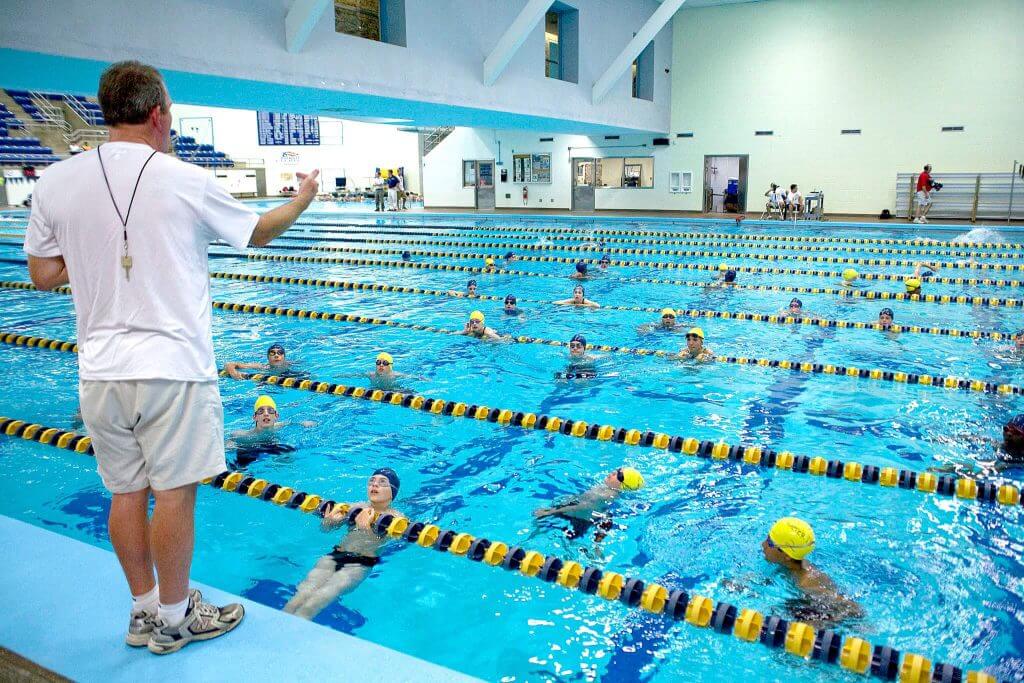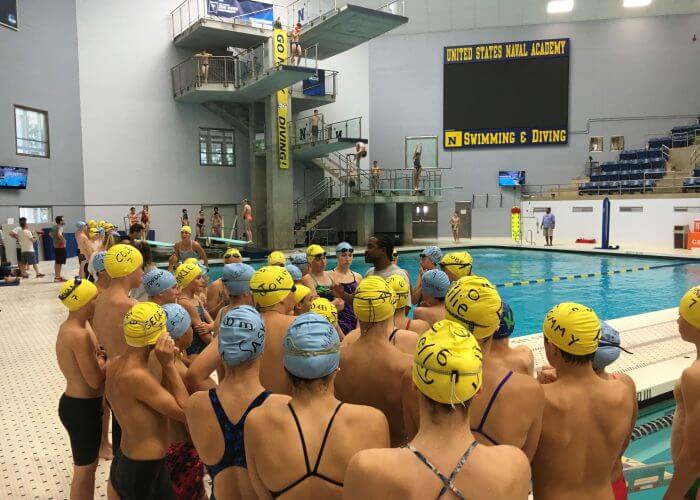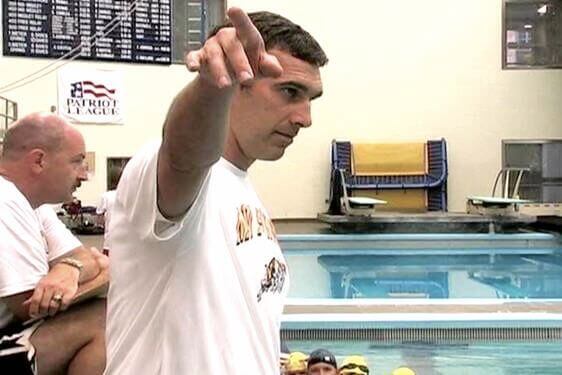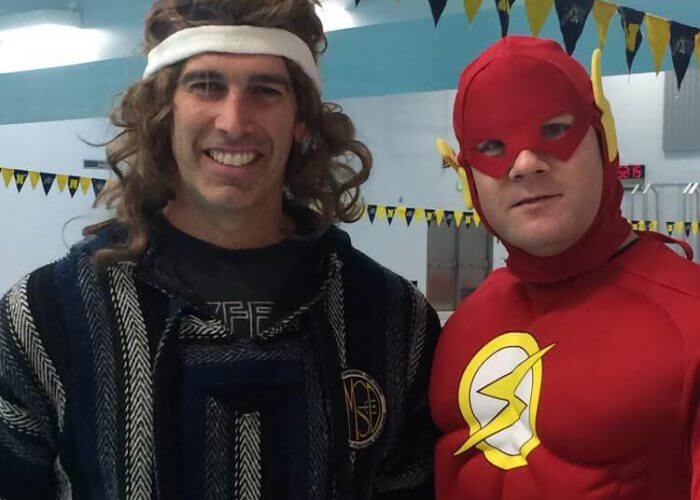Summer Swim Camps Like Navy Are Stroke And Training Intensive

by Michael J. Stott, Swimming World staff writer
For the fortunate and committed, single or multi-week summer swim camp sessions offer an ideal opportunity to learn technique, polish strokes and experience rigorous training with different teammates in a specialized environment. Another huge bonus is that campers get to learn from other coaches in way that improves or reinforces what they already learned from their home programs.

Photo Courtesy: Bill Roberts/Navy Swim Camp
Summer swim teams are one thing—and there are hundreds of really good ones nationwide. Swim camps are a step up. Many are held on college or prep school campuses. That means away from home. Most all focus on starts, turns and getting faster and more technically proficient in each competitive stroke. Collegiate swimmers as well as college and club coaches populate the deck. And at least one camp advertises that graduates have won 43 gold medals and set 11 world records.
Like most summer sessions, the camp at the United States Naval Academy in Annapolis is stroke-intensive. But it also offers optional sessions daily dedicated to training and conditioning for anyone desiring more volume during camp. In any case, videotaping and personal critiques are de rigeur.

Coach Bill Roberts – Photo Courtesy: Bill Roberts/Navy Swim Camp
Following are some sample sets that Navy coach Bill Roberts uses with his campers:
FREESTYLE
Concepts presented at the camp focus on body position, leverage, purpose, use of legs, arm mechanics, breathing and overall timing.
After instruction, a camper is likely to experience:
- 6-8 x 25s of coach-led instruction working on the aforementioned concepts (6-8 25s on each concept followed by a short set to practice the skills).
“It is important for students to realize that the skill and application of the skill are two different things. It is incumbent upon us to make sure swimmers first learn a skill, and then be able to apply and connect it to the act of moving forward in the water.” – Coach Roberts
Practice set: 1 x [4 x 25, 2 x 50s, 4 x 25]. The first 25 is swum while applying the newly-learned concepts to the swim. The 2 x 50s are 25 drill/25 swim, the 4 x 25s are descend 1-4.
“The set is not complex by design, but provides swimmers the best chance to really rehearse skills.” – Coach Roberts
BREASTSTROKE
Instruction includes the role of the body in forward momentum, arm patterns, leg mechanics, breathing and head position, streamlining and overall timing.
“Breaststroke is tremendously complex with many moving parts,” says Roberts. “In a camp situation where you have less time together than in a team setting, you have to be super-organized with your teaching progression if the kids are to get anything out of the instruction. The other challenge is getting each swimmer to think like a breaststroker for those specific sessions. We really challenge all campers to engage in the instruction to avoid the trap of thinking that this does not apply to them because they never swim breaststroke.” – Coach Roberts
Sample set: 8 x 25s, odds are kick only in a streamline position with snorkel.
“All swimmers are expected to squeeze their bodies into perfect streamline position. Evens are LONG Glide breaststroke. When pool is set to long course, we will do a 50-meter effort, taking the least strokes possible.” – Coach Roberts
BACKSTROKE
“Our coaches again stress body position and leverage, purpose and use of the legs, head positioning, arm mechanics, dolphin kicking—especially transitioning to the surface—and overall timing,” says Roberts. “Timing is important in all strokes, but especially here, where poor timing will prevent swimmers from reaching their potential. As coaches, if we can just isolate and dissect timing, I am confident we will make significant improvements even within the short-camp time frame.” – Coach Roberts
Sample set: 6-8 25s of coach-led instruction reviewing breaststroke.
Practice set: 3-6 sets of :10, :15 or :20-second vertical kicking.
“After VK, swimmers will perform repeat efforts of dolphin kicking while pushing off the pool floor. With this activity, swimmers can focus and rehearse multiple skills in a fun and challenging way. We have found this to be a great way to begin a session. One challenge/camp contest we introduce is having each swimmer timed for a certain distance underwater while counting their kicks. After further instruction or at the end of the session, we return to this same challenge to hopefully see some measurable progress.” – Coach Roberts
BUTTERFLY
Initial instruction addresses the pressing of the chest to create proper forward movement, head position, breathing, dolphin-kicking and arm mechanics.
“In camp, I find that head position is where the most improvement occurs. Many swimmers, young and old, will lead butterfly strokes with excess head motion. If we can improve the head movement efficiency, it generally allows swimmers to pick up other butterfly elements more quickly.” – Coach Roberts
Sample set: 6-8 25s of coach-led instruction, then 8 x 50 LC as follows:
- #1-2 Take eight fly strokes for distance off the wall, then swim perfect free to the other end.
- #3-4 Even strokes fly for distance; try to go as far as you went on #1-2.
- #5-6 Six strokes fly for distance; beat your distance on #3-4.
- #7-8 Five cycles fly for distance; beat your distance on #5-6.
TRAINING SET
X* [4 x 150, even split, 4 x 100]. Kick on Round 1, K/S on Round 2, swim and build leg effort on Round 3. (X* means coach determines the number of repeated rounds.)
“This is an excellent pattern that can be used in several training scenarios. The pattern is not absolute and can be manipulated in a variety of ways. I credit Coach Chris Morgan, now with the Gator Swim Club, for this set.” – Coach Roberts

Photo Courtesy: Bill Roberts/Navy Swim Camp
Thankfully, the camp experience is not all instruction and laps. Organizers go to great lengths to program fun into water, instructional and free time. For age-appropriate campers, activities may also include significant dryland, skull sessions on mental training, goal setting, nutrition and the importance of being a good teammate. All in all, for many, the summer swim camp experience is educational and transformative in every sense of the word.
Looking for a Last Minute Summer Camp? Click Here




Sue Knickerbocker Brode I went to one before!
Thanks for this wonderful article.
Summer camps are a great way for athletes, of any ability, to get better and be reminded that swimming is really a joyful process. For coaches, a lot of time it reminds them why they chose the profession in the first place.